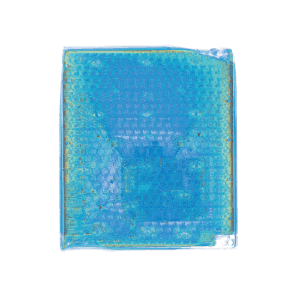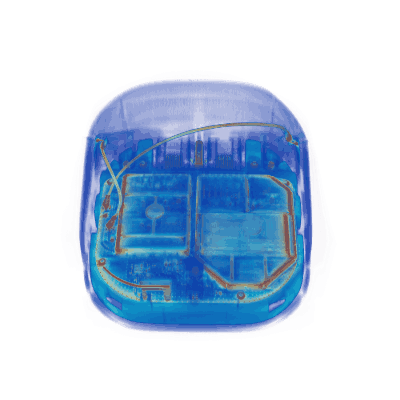
Starlink Mini
SpaceX, 2024
The Starlink Mini is SpaceX’s latest generation of user terminal, released in 2024 after years of iteration on the original flat-panel design. It connects homes and field teams to SpaceX’s constellation of more than 6,000 low-Earth orbit satellites. Each terminal maintains a live, moving link to orbit, transmitting and receiving focused beams of data through an electronically steered phased array instead of a mechanical dish.
Inside, a dense grid of aperture-coupled patch antennas converts electrical signals into electromagnetic waves. Each patch includes two crossing feed lines beneath copper disks, one for transmitting and one for receiving. Measuring only a few millimeters across, these antennas operate in the Ku-band (12–18 GHz), the same frequency range used by most satellite constellations. H-shaped slots polarize each wave so that the signal maintains its correct orientation as it travels to and from orbit.
Below the antenna layer, the beamformer circuit handles the system’s coordination. By adjusting the phase and amplitude of signals across the array, it electronically steers the beam’s direction through constructive and destructive interference. This allows the terminal to track satellites without moving parts, keeping a precise and continuous link even as the spacecraft moves overhead at thousands of miles per hour.
At the back of the unit, the WiFi router acts as the bridge between the phased array and local connectivity. Dual-band radios and signal processors distribute data to nearby devices over Ethernet and WiFi, while power and control circuits regulate the system’s energy use. It is the local endpoint of a global network that turns satellite bandwidth into internet access on the ground.
The Starlink Mini marks a turning point in communications hardware. It condenses what once required a full ground station into a portable, self-contained device. In our recent Go/No-Go podcast interview, Bridgit Mendler and Griffin Cleverly of Northwood Space described how similar phased array systems are scaling across the industry to build distributed ground networks. Together, these technologies—portable terminals in the field and modular ground stations worldwide—are closing the gap between orbit and Earth, transforming space into part of everyday infrastructure.
Listen to Bridgit Mendler on Go/No-Go

Mesh Wi-Fi Router
Eero, 2022
The Eero 6 Plus is part of a new class of WiFi systems designed to create a seamless network across an entire home. Unlike the directional satellite link used by Starlink, which connects to a constellation in orbit, Eero builds a terrestrial mesh. Each node communicates with the others, dynamically routing traffic to maintain strong connections throughout a building. Founded in 2014 and acquired by Amazon in 2019, Eero pioneered easy-to-use mesh WiFi that turned complex enterprise networking ideas into a plug-and-play consumer product.
Here we can see the router’s dual antennas, each soldered to a wire leading to inverted-F antennas embedded in the plastic housing. This compact antenna design is widely used in smartphones and routers because it can be tuned precisely for 2.4 GHz and 5 GHz WiFi bands. The bent, curved shape allows it to fit efficiently within the enclosure, providing good gain while minimizing interference between channels.
The main PCB contains the wireless modules and supporting microcontrollers. Two Faraday cages wall in critical components: one for the WiFi system-on-chip (SoC) and another for the Bluetooth and memory subsystems. These shields protect sensitive circuits from electromagnetic interference, ensuring consistent signal strength and preventing cross-talk between radios that share the same physical space.
At the base of the board sit the Ethernet ports, power regulation circuits, and the main board-to-board connector. Two small transformers at the LAN ports keep the module electrically isolated and contain common-mode chokes to suppress RF noise, forming the interface between the router and the world of power and data lines.
Eero’s design represents the ground-level counterpart to the Starlink system: where one connects Earth to orbit, the other connects room to room. Its modular architecture and distributed intelligence illustrate how networking has scaled down into the home, making mesh connectivity as seamless and resilient as the cloud itself.

GPS Module
HGLRC, 2024
The Eero router shows how a network stays connected within a home, but it doesn’t need to know where it is. Wi-Fi only manages local links. This tiny HGLRC M100-5883 GPS module fills that gap by providing positioning data. In larger systems like satellites, drones, and connected vehicles location and timing are as critical as connectivity itself. Starlink’s GNSS STA8089 chip performs this role on the ground station, telling the array exactly where it sits on Earth and when to steer its beams toward moving satellites. This HGLRC module does the same job at a different scale, giving autonomous aircraft and robots the geographic awareness needed to navigate, measure, and map the world.
The ceramic patch antenna forms the core of the module. Its layered design—metal patch on top, ceramic dielectric in the middle, and a ground plane on the bottom—slows down the signal’s velocity, which shortens the wavelength and allows you to shrink the physical antenna size. It’s tuned precisely to 1.575 GHz, the L1 GPS frequency. The small feed pin off to one side carries the signal to the PCB, offset to match the right-hand circularly polarized GPS waves that spiral down from orbit.
In this view of the PCB, we can see the RF receiver. This chip takes the faint, right-hand circularly polarized GPS signals from the antenna and converts them into electrical data that the processor can interpret to determine position. A nearby magnetometer functions as a digital compass, measuring the Earth’s magnetic field to determine the device’s orientation. Together, these sensors provide both location and heading, which are passed to the main system through the board-to-board connector.
GPS is the foundation of modern autonomous systems. Drones depend on it not just to navigate, but to pin every photo, scan, and sensor reading to a precise point on Earth. That geospatial data makes their work useful, whether mapping infrastructure, surveying land, or inspecting hard-to-reach sites. As we discussed with Skydio CEO Adam Bry, reliable positioning is what turns flight into actionable insight.
Listen to Adam Bry on Go/No-Go

iPhone Air
Apple, 2025
The iPhone Air represents the most compact and refined expression of connectivity in this series. Every previous device we scanned handled distance, distribution, or position. The iPhone Air integrates all of these, combining global connectivity with personal precision. Inside, a web of antennas, chips, and connectors translates airwaves into information across Wi-Fi, Bluetooth, 5G, GPS, and ultra-wideband signals.
In this scan, the darker blue region near the camera module reveals the phone’s sub-6 GHz 5G antenna. Rather than being placed along the edge, Apple tucked it beside the camera array to make the most of the limited space in the ultra-thin housing.
Board-to-board connectors form the nervous system of the phone. These high-density contacts link the main logic board with the antenna, power, and sensor assemblies. Each connector is built to minimize loss and resist fatigue under heat and vibration. Their layout in the Air reflects Apple’s focus on repairable thinness: the logic board sits above the battery, leaving direct, flat access for disassembly.
Near the center lies the UWB board containing Apple’s U2 chip. This module handles precise spatial awareness, sending and receiving short radio pulses to measure time-of-flight distances within centimeters. It underpins AirDrop directionality, Find My, and device handoff. The module’s design, visible in our scan, includes multiple shielded sections for noise isolation and a compact matching network for the antenna array.
The Air’s sub-6 GHz 5G slot antenna works in tandem with the four plastic passthroughs built into the iPhone Air’s titanium frame. These radio-transparent windows let electromagnetic waves escape without weakening the phone’s structure. Each plastic insert isolates a small section of the titanium shell, forming four discrete radiating zones. The slot antenna sends radio frequency signals into these gaps, using the surrounding metal as part of the radiating structure. This design enables wide bandwidth coverage from 600 MHz to 6 GHz while maintaining isolation from other radios.
Here, you can see the slot antenna’s three metal plates, along with two narrow gaps (slots) between them. When an RF current flows into the metal plates from their feedlines, electromagnetic fields leak across the gaps and excite the iPhone’s chassis, turning the metal case into an efficient antenna. The result is a system that combines advanced radio engineering within a sleek form factor.
Explore the rest of the iPhone Air’s design with iFixit
From orbit to pocket, every antenna in this story solves the same problem under different constraints. Together they show how connectivity has become a layered system where space, infrastructure, and personal devices now form a single network, quietly translating energy into information everywhere we go.





